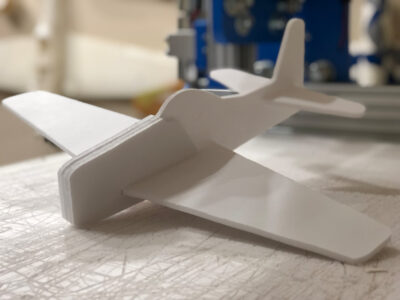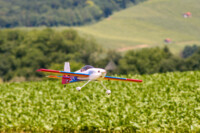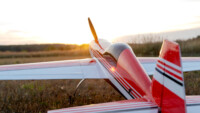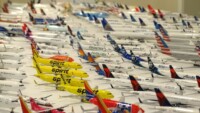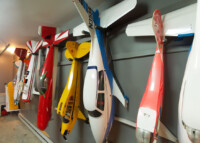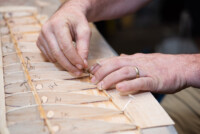What Foam is Best for Model Airplane Construction?
9 November 2023 | Updated on January 03, 2024
When it comes to building model airplanes, choosing the right foam is crucial for achieving optimal performance and durability. With several foam options available, it’s important to understand the advantages and considerations of each to make an informed decision.
Some popular choices for model airplane foam include Depron, BlueCor, Foam Board, and Fli-Power XPS. Each foam option has its own unique characteristics and benefits, catering to different project requirements and personal preferences.
Depron is a trademarked brand of closed-cell extruded polystyrene foam that offers great performance and ease of use. BlueCor, on the other hand, is a waterproof and flexible foam ideal for wire-cutting wings and carving fuselages. Foam Board is a cost-effective option with easy cutting and bending capabilities. Fli-Power XPS, a weatherproof foam, is perfect for shaping wings and fuselages with its flexibility and precision.
Consider factors such as stiffness, flexibility, waterproof properties, ease of workability, and cost when selecting the best foam for your model airplane construction. It’s important to choose a foam that suits your specific needs and project requirements.

Key Takeaways:
- Choosing the right foam is essential for model airplane construction.
- Popular foam options include Depron, BlueCor, Foam Board, and Fli-Power XPS.
- Consider factors such as stiffness, flexibility, waterproof properties, ease of workability, and cost when selecting foam.
- Each foam option has its own advantages and considerations.
- Make an informed decision based on your specific needs and project requirements.
Depron Foam for Model Airplanes
| Advantages | Considerations |
|---|---|
|
|
Depron foam is a popular choice for model airplane construction. It is easy to work with, cuts well with a sharp knife, and is easy to tape, sand, and glue. Depron is a closed-cell extruded polystyrene foam that is sold as wall insulation and flooring substrate. It is also marketed for arts projects and RC modeling. There is even a variety of Depron specifically manufactured for RC use called Depron Aero. This foam is known for its stiffness, which means that spars or stiffeners are rarely needed. It is also waterproof and comes in large sheets with tolerance thicknesses. While Depron can be more expensive compared to other foams, the long life and performance characteristics make it a worthwhile investment for model airplane builders.
When using Depron foam, no additional stiffeners or spars are usually necessary due to its inherent stiffness. This makes it easier to build lightweight and aerodynamically efficient model airplanes. Depron Aero, the RC-specific variety of Depron, is especially popular among RC modelers for its performance and durability.
Overall, Depron foam is a versatile and reliable option for model airplane construction, offering durability, ease of use, and excellent performance.
BlueCor Foam for Model Airplanes
When it comes to model airplane construction, BlueCor foam is a popular choice among hobbyists. Also known as small-cell Styrofoam, BlueCor offers several benefits that make it ideal for building model airplanes. This closed-cell extruded polystyrene foam is less stiff and more flexible than other options, making it perfect for wire-cutting wings and carving out fuselages.
One of the unique features of BlueCor foam is its superior strength-to-weight ratio. This makes it a preferred choice for building full-scale, moldless, composite, experimental airplanes. The foam’s flexibility and strength allow for the creation of complex shapes and structures without compromising on durability. BlueCor foam is also easy to cut, sand, and shape, giving model airplane builders the freedom to design and customize their aircraft.
While BlueCor foam offers many advantages, it’s important to consider a few factors when using it. Due to its flexibility, additional reinforcement may be required in certain areas to maintain structural integrity. Some model airplane builders reinforce BlueCor foam with carbon fiber spars or stiffeners to ensure optimal performance. Additionally, it’s worth noting that BlueCor foam is less rigid than other foams, which may affect flight characteristics. However, with proper design and construction techniques, this can be effectively managed.
BlueCor foam is a versatile and reliable option for model airplane construction. Its flexibility, strength, and ease of workability make it a popular choice among hobbyists. Whether you’re building a model airplane for display or for active flying, BlueCor foam provides the necessary qualities to bring your design to life.
BlueCor Foam Comparison
| Characteristics | BlueCor Foam | Depron Foam | Foam Board |
|---|---|---|---|
| Flexibility | High | Low | Medium |
| Rigidity | Low | High | Medium |
| Strength | High | Medium | Medium |
| Waterproof | No | No | No |
| Ease of Workability | Easy | Easy | Easy |
| Cost | Medium | High | Low |
Foam Board for Model Airplanes
Foam board is a popular and affordable foam option for model airplane construction. It is a polystyrene foam sheet with paper backing that provides rigidity and ease of decoration. Foam board is easy to cut and bend around curves, making it suitable for creating complex shapes. It is readily available at Dollar Tree stores for a low price, making it easily accessible for model airplane builders. However, Foam board does have some drawbacks, such as limited sheet size, delamination of the paper backing over time, and variations in thickness and flatness. Despite these drawbacks, Readi-Board remains a popular choice due to its affordability and ease of use.
To give you a better idea of the characteristics of foam board, let’s take a look at a comparison table:
| Characteristic | Foam Board |
|---|---|
| Material | Polystyrene foam with paper backing |
| Availability | Readily available at Dollar Tree stores |
| Price | Affordable |
| Size | Sheets have limited size |
| Backing | Paper backing that can delaminate over time |
| Thickness | Variations in thickness and flatness |
| Workability | Easy to cut and bend around curves |
Despite its limitations, Foam board is a popular choice among model airplane builders thanks to its affordability and ease of use. While it may not offer the same level of performance and durability as other foam options, it is a great choice for those on a budget or for less demanding projects. With a bit of creativity and skill, foam board can be transformed into beautiful model airplanes that are ready to take to the skies.
So, if you’re looking for an affordable foam option for your model airplane construction, foam board is definitely worth considering. Its ease of use and accessibility make it an attractive choice for both beginner and experienced model airplane builders alike.
$35.97
$39.97 

Fli-Power XPS Foam for Model Airplanes
Fli-Power XPS foam is a relatively new foam option for model airplane construction. Made of expanded polystyrene, it offers weatherproof properties, making it ideal for outdoor use. This foam is less rigid than Depron but more flexible, allowing for easy forming and bending. With its precise sheets and large format, Fli-Power XPS foam is perfect for creating modular fuselages and shaped wings.
Fli-Power XPS foam is known for its versatility and durability. It can be used to fold airfoil shapes by adding a layer of tape to support the leading edge curve during bending. This foam also has the ability to withstand the normal dings and knocks of RC flying, ensuring a longer lifespan for model airplanes. While it may be more expensive compared to other foam options, the quality and flexibility of Fli-Power XPS foam make it a worthwhile investment for model airplane builders.
When choosing Fli-Power XPS foam for airplane construction, it is important to consider its unique properties. This foam offers a balance of stiffness and flexibility, allowing for ease of shaping and forming. Its weatherproof nature makes it suitable for outdoor use, providing peace of mind for flying in various weather conditions. Additionally, the precise sheets of Fli-Power XPS foam allow for accurate and consistent results, ensuring high-quality model airplane construction.
Wood vs. Foam for Model Airplanes
When it comes to choosing between wood and foam for model airplane construction, there are distinct advantages to consider for each material. Wood model airplanes offer a classic and traditional look, providing an aesthetic appeal for enthusiasts. The use of wood also allows for a smooth finish, making it easier to achieve a polished appearance. Additionally, wood is easy to work with and can be painted or covered with film for customization.
“Wood model airplanes offer a classic and traditional look, providing an aesthetic appeal for enthusiasts.”
On the other hand, foam model airplanes offer a range of advantages that make them a popular choice among builders. Foam is lightweight, which contributes to better maneuverability and increased flight performance. It is also durable and can withstand normal dings and knocks during RC flying. Foam models are often easier to repair compared to their wooden counterparts, as foam can be easily patched or replaced.
Another advantage of foam model airplanes is their versatility. Foam comes in various forms, such as molded foam or thin sheets that can be cut and glued together, allowing for the creation of complex and unique shapes. Additionally, foam model airplanes are available as Almost Ready to Fly (ARF) options, providing convenience for model airplane enthusiasts who prefer pre-built components.
Advantages of Wood Model Airplanes:
- Classic and traditional look
- Smooth finish
- Easily customizable with paint or film
Advantages of Foam Model Airplanes:
- Lightweight for better maneuverability and flight performance
- Durable and resistant to dings and knocks
- Easier to repair
- Versatile in creating complex shapes
- Available as Almost Ready to Fly (ARF) options for convenience
When choosing between wood and foam for model airplane construction, it ultimately comes down to personal preference, desired appearance, and specific project requirements. Both materials offer unique advantages, and the best choice depends on the individual builder’s needs and preferences.
Factors to Consider When Choosing Foam for Model Airplanes

When choosing foam for model airplane construction, it is important to consider several factors to ensure the best possible outcome. These considerations will help determine the right foam for your specific needs and preferences. By taking these factors into account, you can make an informed decision that will result in a successful and enjoyable building experience.
Stiffness and Flexibility
One important factor to consider is the stiffness and flexibility of the foam. Some projects may require a more rigid foam, while others may benefit from increased flexibility. Evaluate the requirements of your specific model and choose a foam that aligns with those needs.
Waterproof Properties
Consider whether the foam you choose needs to have waterproof properties. If your model airplane will be exposed to water or moisture, selecting a foam option that is waterproof will help ensure its durability and longevity.
Ease of Working
The ease of working with the foam is another crucial consideration. You want a foam that is easy to cut, sand, and glue to make the building process smooth and efficient. Choose a foam that allows you to work with it easily and achieve the desired shapes and structures.
Cost and Availability
Cost is an important factor for many builders, so consider your budget when selecting foam for your model airplane. Additionally, think about the availability of the foam. Some foams may be more readily accessible in your area than others, so take this into account when making your decision.
By considering these factors when choosing foam for model airplane construction, you can select the foam that best meets your needs and ensures a successful building experience. Whether you prioritize stiffness, waterproof properties, ease of working, or cost, there is a foam option out there that will suit your requirements and help you create the model airplane of your dreams.
Conclusion
When it comes to choosing the best foam for model airplane construction, there are several options to consider. Depron, BlueCor, Foam board, and Fli-Power XPS all offer their own unique advantages and considerations. Each foam option has its own stiffness, flexibility, and waterproof properties, allowing builders to select the foam that best suits their specific project requirements.
Wood model airplanes provide a traditional look and feel, while foam model airplanes offer versatility and durability. Both have their own benefits and can be chosen based on personal preferences and desired appearance. Whether you opt for wood or foam, the most important thing is to have fun and enjoy the process of building and flying model airplanes.
Factors such as ease of workability, cost, availability, and size requirements should also be taken into account when making a decision. By considering these factors and understanding your own preferences and budget, you can make an informed choice for your model airplane construction.
In the end, there is no one-size-fits-all answer to the question of which foam is best for model airplane construction. The choice ultimately depends on your individual needs and preferences. So, take your time, do your research, and select the foam that will help you create the model airplane of your dreams. Happy building!
FAQ
What foam options are available for model airplane construction?
Some popular foam options include Depron, BlueCor, Foam board, and Fli-Power XPS.
What is Depron foam?
Depron is a trademarked brand of closed-cell extruded polystyrene foam that is easy to work with and offers great performance characteristics.
What is BlueCor foam?
BlueCor is a waterproof and less stiff foam that is ideal for wire-cutting wings and carving fuselages.
What is foam board?
Foam board is a polystyrene foam sheet with paper backing that is easy to cut and bend around curves.
What is Fli-Power XPS foam?
Fli-Power XPS is a weatherproof foam that is flexible and precise, making it perfect for shaping wings and fuselages.
What are the advantages of wood model airplanes?
Wood model airplanes offer a traditional look and feel, and models built with wooden structures often have a smooth finish.
What are the advantages of foam model airplanes?
Foam model airplanes offer versatility and durability. Foam is lightweight, sturdy, and can withstand normal dings and knocks of RC flying.
What factors should be considered when choosing foam for model airplanes?
Factors to consider include the stiffness and flexibility of the foam, waterproof properties, ease of working with the foam, cost, and availability.
